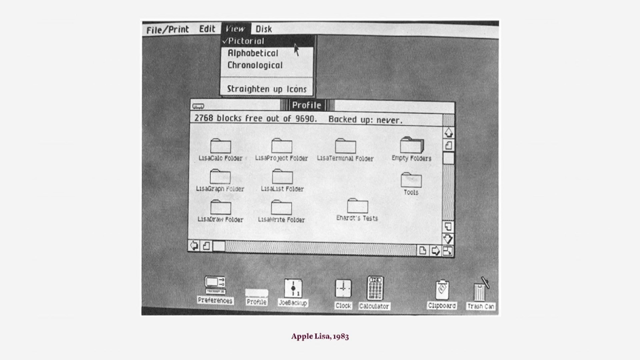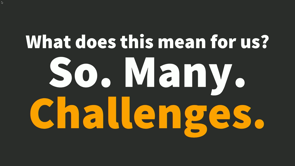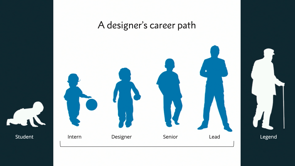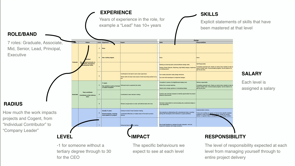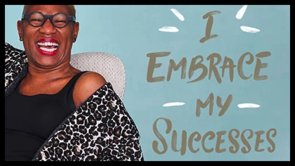
(energetic music) - I wanna give a quick shout out to Kat who's doing an amazing job on the Twitter feed. Don't look, but just shout out.
Amazing work, so if you're following the Twitter feed, it's fantastic.
I'm Josh Kinal, I'm a lead designer at ThoughtWorks and my title's actually lead experience designer. And that means I actually design experiences. I design the experiences of and for people who use technology and people who work with people who use technology. And in that process I make sure that we have reason, thought, expectation, and an opportunity to adjust when required. My primary goal when I work is to make sure that nobody's life is more difficult than it needs to be. Just in case you have to an urgent call or something, you really need to go to the bathroom, you just think you cannot stand listening to me anymore, if this is the only message you get out of this talk, then it's enough.
Make a list of moral principles for the thing that you are working on right now. Put them up on a wall, refer to them regularly, ask yourself if you're still living up to them, ask yourself if they're still relevant in three months. And if that's all you get out of this, then that's great. But there is so much more to this talk.
Let's talk about ethics.
Ethics are really unhelpfully defined as a collection of moral principles.
Yay, thanks philosophers, that's tops.
Morals on the other hand, this very binary distinction between right and wrong, good and bad.
Killing, is bad.
Giving charity is good.
Stealing is bad.
Saving someone else's life is good.
That sort of thing.
It sounds really easy.
Have a set of principles, those are the kinds of things that are principles, that's all you should need.
Here's an example of some moral principles from Polonius. You might know him as Laertes' father.
No? No one really? Ring a bell? He's a character in Hamlet.
He lays out these moral principles for Laertes to follow while, so Laertes, his son, is heading off to France because that's what people did when they lived in Denmark, going off to France.
And while these sound perfectly valid they don't really allow for any wiggle room. It would be easy to say that Polonius is what we would call a moral principalist. He believes there is no reason to go against this sound advice and you might have heard some of these lines, like neither a borrower nor a lender be, and to thine ownself be true.
I asked a colleague if they knew where those quotes came from, and they said, I don't know, really familiar, so I'm guessing the Bible? That's how much these sound like principles. They sound like they're given from up on high. Moral principalists believe in a purely binary morality. Things are either good or bad.
They're either right or wrong.
Moral principalists are not fun at parties. Polonius, who you might remember from the previous slide, claimed to be moral but spends the entire play interfering in other people's business through spying and spreading rumours and this ultimately leads to him being stabbed while he's hiding behind a curtain in a case of mistaken identity.
But what does this have to do with design? Design is a process of planning, or an attempt to realise intention for a thing.
It's again, not very specific but eh.
That thing might be a website, a costume, a 50 dollar note. It might be a great new drug that kids are gonna crave at all the excellent parties.
It might be a magazine that tells designers who other great designers are and how those great designers do design.
Design and ethics are not natural bedfellows. They need to be encouraged together because design has many stakeholders and a lot of them control money or access to it. And money is not inherently ethical.
It's also not inherently unethical.
It just is.
We cannot apply an ethic to money.
But money does lead people to make many decisions that can harm people.
I found it useful to make a distinction for people between goals and principles.
My personal mental model of a goal is of a soccer pitch. It stands by itself and a team of people have to work together, collaborate, communicate to actually get a ball through a physical thing. That thing is some kind of archway at the end of a pitch. Principles are more like the rules of the game. Breaking them is cheating them.
You have a ball you need to get to the goal, but you're not allowed to touch it with your hands. You're not allowed to touch another player. There are all of these rules.
Principles can be seen as the constraints that try to stop us from achieving our goals. But they can also be seen as guides to let you know you've achieved your goal without creating some kind of unfairness.
So let's look at a couple of things that were definitely created with a set of principles and should therefore be considered ethical. This is a drawing of an M-16 rifle.
It was designed with principles.
The principles are separate to its goal.
The goals of its design were to produce a rifle that could be switched from fully automatic to semi-automatic as required. It needed to be able to use ammunition more efficiently than its predecessor, the now much-publicized AR-15. It had to be reasonably lightweight.
Less than four kilogrammes, I don't know what that is in pounds, and there's no way of working that out.
And this is really important.
It's ammunition had to be able to pierce the helmet of a 1960s military soldier.
Those are the goals.
But the principles that were upheld during the design of the M-16 rifle were that A, warfare demands that a military must defend itself and that a good defence is to eliminate an attacker. One of the key principles of this product.
Another is that victory in warfare is fundamental to maintain a people's identity when under attack. Victory is more likely with a better arsenal than those of our enemies.
Those are the principles of the M-16 rifle. And the great thing about philosophy is that it can really be an opportunity to just pose asshole questions like this and leave them hanging.
The rifle has a set of principles, therefore it has ethics, but could you call it ethical? Let's move on to a subject that's a lot less violent and maybe we can relate to a little bit more. Double-muscled pigs.
Anyone aware of these? They're a wonder of modern science.
Originally using the gene editing enzyme known as TALEN. Oh does anyone have a background in biological sciences, molecular biology? Yeah, you and me. Great.
So originally using enzyme known as TALEN and more recently changed to using the highly publicised CRISPR.
A collaboration between Chinese and Korean scientists produced a set of pigs literally with muscles on top of their muscles.
These particularly happened around the rumps, that's just the way it worked.
I'm gonna leave you to search for your own images of these pigs.
I just drew a nice little pig face that you might wanna see. The goals of the double-muscled pig project were to see if TALEN could be used to cut myostatin, which is the gene that regulates muscle growth in all mammals.
Therefore, it could produce a pig that can provide more meat per oink than any other varieties, and that's it.
It's a simple goal.
A growing population needs to be fed.
Let's grow a pig that has more meat on it.
And the principles of the double-muscled pig are a lot harder to infer, a lot more difficult to infer.
Because different universities have different ethics committees.
And this was a kind of co-production between two universities.
One in China, one in Korea.
What we do know is that the scientists Xi-jun Yin from China and Korea's Jin-Soo Kim, declare that they do not intend for these pigs to be farmed.
Instead, they want the semen from these pigs to be sold to farmers who can then inseminate their own sows that will therefore create progeny that only have half the myostatin genes cut out. Which means they're not really gonna be double-muscled pigs, they'll probably be 1.5-muscled pigs.
That should lead to a healthier animal while still providing more porks per oink.
And aren't rhetorical questions annoying? I want to declare my own biases here, I think the M-16's primary purpose is to kill or wound many people in a short period of time. And that idea is abhorrent to me.
I think double-muscled pigs are monsters engineered only for human greed without any foreseeable benefit to the continuation of the world.
Everyone has biases.
It's human.
Often when we produce a set of principles we reveal our biases through what we omit.
Usually what we omit are the exceptions and our responsibility to them.
Here's another bias.
I design for money.
It's not a hobby, it's a profession.
I'm a professional designer.
I get paid, hopefully we all get paid.
But as soon as we get paid, there's an opportunity for us to be corrupted. That is just one of the natures of money, as it exists. More on that soon.
Ah, this is where it recently (mumbles).
Anyway, no one cares about that.
Moral particularism.
Moral particularism suggests that principles are flawed because it's impossible to make a single declaration that is always going to be useful for all situations. It's not that principles are irrelevant, it's more that they're not universal, eternal, or robust. Principles make it too easy to be hypocritical, or in Polonius' case, a meddling asshole who really gets what he deserves.
The most basic example is that we can agree that killing someone is wrong, but if we kill our assassin, sorry, if we kill our assailant in the process of defending ourselves, then that's right. It's a justifiable killing.
There are exceptions applicable to every principle. Which means the principle cannot be to its ownself, true.
So why did I tell you to do this at the beginning of the talk? Principles are still really important to a project. They are paramount to the work we do as designers. They are equal in importance to the idea from which the design grows.
Design starts with an idea, it should also start with principles.
As the design evolves, the principles and concept of them should evolve with them. They give us guidance to help avoid bringing something truly reprehensible into the world.
And something truly reprehensible is what Mikhail Kalashnikov, who was an engineer and designer, not a famous Russian ballet dancer, created. This is a quote he wrote to the head of the Russian Orthodox Church two years before he died.
His rifle was the gun the US military was trying to outdesign, when they created the M-16.
It was the AK-47.
Moral principles exist in stasis.
They might be true now, but they might not be true in different circumstances.
That's the point of moral particularism.
It's true that the principles behind the design of the M-16 were contrary to human safety.
They wanted to be able to pierce a military's, a 1960s military helmet, for fucks' sake.
But they were not contrary to civilian safety. The principles we spoke about earlier were only with respect to the rifle being used in warfare. This is a perfect example of the old adage, that we're always fighting the last war.
When we design products, we need to think about the future. We need to think about future uses for the products that we're making.
Product design is not just about the physical or interactive product.
It's about its life after use, the end of life for a product needs to be built into its design.
Similarly, its management, in other circumstances. We see this now a lot, with what the hell do we do with all of our recycling? What if the production of the M-16 had for example, built into it, something that only made it possible to be used in military circumstances.
Or what if the US military never made the gun available to any market? And only produced it for its own use? Would that have changed the ethics of the M-16? What happens when the double-muscled pig farm has its fences breached and the pigs escape? Selective breeding has already created a significantly different pig from wild pigs. But could double-muscled pigs survive in the wild or would their bulk adversely affect their bones and joints? Would they destroy wild habitats? Will farmers stick to breeding pigs with only half the myostatin, using only the semen that is provided? Or will they breed them together so that they can start their own breed of truly, overly muscly pigs to maximise the amount of meat that they can produce? You might start thinking that we can't really talk about morality in design without talking about the way businesses work. To earn money, to continue to pay us to design. So everyone take a breath, or don't, I mean, your choice.
This is just a brief interlude into how good businesses work.
There's a tool that we use when working with businesses called the Lean Value Tree.
And we use it to try to align a business to work towards common goals and a single common vision. I'm not sure how many of you are familiar with this, but this is what it looks like.
At the very top, you have a vision.
And the vision is an unreachable, almost unrealistic view of the future.
Something like, end world hunger.
Never gonna happen, but it's definitely worth trying for. Goals, are realistic, but still outrageous. For example, you might just try to end hunger in your own country.
Then you have this bets layer, which I've always found a weird concept, I think of it more like a Lean hypothesis layer, and if you're familiar with that format, then this could kinda take the form of, we believe that if we successfully farm plankton, we can create a low-cost, easily distributable food. And then this bottom layer is the initiatives. And that's usually where we work as designers. This is where we build the products, and where design sits within the business.
And there are lots of initiatives that are all producing lots of value that all go towards proving the bets true or false, that then work towards the goals, that make the vision more credible.
So value flows up the chain, concepts flow down the chain.
Each layer has its own measure of success, which provides a definition of value to the whole tree, so it becomes easy to see if each piece is doing its own part.
This is how modern business works.
This is how modern business thinks.
And there is one glaring omission from this picture. Guiding principles aren't mentioned anywhere in the Lean Value Tree.
There's no prioritisation of principles, or discussion of morality.
The measures of success are usually some kind of score from a survey, or something actually countable, like money or happiness? And measures of success only look at the positive side for our benefit.
There's no measure of failure.
If for example, we manage to end world hunger. But only because we started serving the poor human flesh while pretending it was some kind of plant product. Money, its accumulation, the mere idea of wealth, creates a bias in the work we perform.
We cannot ignore our understanding of people's relationship to money when designing products. These things are unavoidable.
Sometimes, they're inherent in the purpose of design. That's definitely the case for the double-muscled pigs. The only reason for them to exist is to increase yield. Sometimes these biases only reveal themselves later. During the poorly titled Cold War, the most popular weapons in armed combat were the AK-47, sold by the Soviet Union, and the M-16, sold by the United States.
And of course, the United States, having some unnatural relationship with the concept of guns, the M-16 was also sold to civilians just in case they one day, needed to create their own militia to protect the union they'd created.
After the Cold War ended, so was the AK-47. And that's progress.
So it's not enough to design principles now, we need to design with a set of if-this-then-that instructions to get us to what the particularists call the moral status. The moral status is about how moral your product is at this very moment.
A great example of this is something that finally gets us back to web design.
YouTube.
YouTube's current moral status is low.
Last week Bloomberg reported that executives had been repeatedly petitioned by employees to remove harmful conspiracy theory videos from the site. New data in this Bloomberg article says that there are fewer than 20 anti-vaccination channels on YouTube that bring in more than 170 million viewers. To put that in some kind of viewer perspective, each Game of Thrones episode is viewed by about 15 million people in the United States when it airs.
The population of Australia is 25 million people. Six times the population of Australia are viewing anti-vaccination videos on YouTube. 170 million viewers is a lot.
And Youtube's algorithms create recommendations for other conspiracy videos for other people's viewing.
And these videos create real harm.
But Youtube's driving force was engagement. Their goal was to increase engagement and they seemed to be guided by their goals, and not their principles.
Remember the principles are separate to goals. Goals are something we strive towards, principles are the rules by which we get there. Youtube's CEO, a year ago, at South by Southwest, claimed that Youtube was really more like a library. Let's put aside the fact that this is clear bullshit. For example, libraries are carefully curated, categorised, and access is only overseen by highly trained professionals. She was standing behind a principle of free speech. She was placing free speech as the principle that for Youtube, outweighed all others.
Except that now, Youtube's principled stance, puts them in a very low moral status.
Now, they are parasites, sucking our engagement, and creating measles epidemics. Youtube's a big company, it's owned by Google, an even bigger company. They once had the principle, very publicly stated, of, to not be evil.
That is a principle, as vague as it is.
They're owned by Alphabet, and nobody knows what their principles are. How do you avoid the mistakes Youtube made? You need to create a process to assess situations. You need to heed warnings, make decisions according to your principles, not according to your goals.
Look at the environment you're in.
When the thing you're designing starts to look like it's going off the rails, like it might hurt someone, like it might have far-reaching unintended consequences that you can't control, look at what you can control in that moment. Look to see if for example, freedom of speech is more important, is a more important principle than avoid harmful activities.
Ask yourself if craving for engagement is more important to you than harm you might be causing to assess your moral status in that moment. Are you justified? Are you just following orders? Are you out of your depth? I didn't do this enough.
So everyone read that? Great, good.
When we design things we are responsible for all the experiences that stem from our design. We build that responsibility into what we build. We need to be careful with how we shape it, and who we let take it into their hands.
Morality isn't a simple binary process.
It's messy and complicated, and changes from moment to moment.
As designers, we have to try to anticipate as many of those moments as possible.
And make sure we're doing the right thing.
Thank you.
(energetic music)







